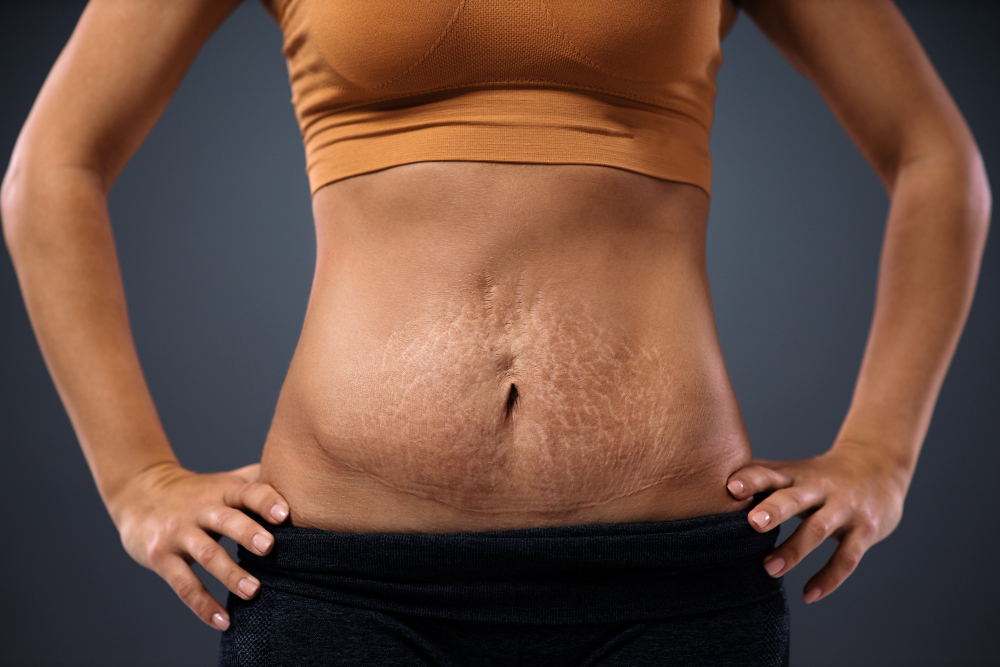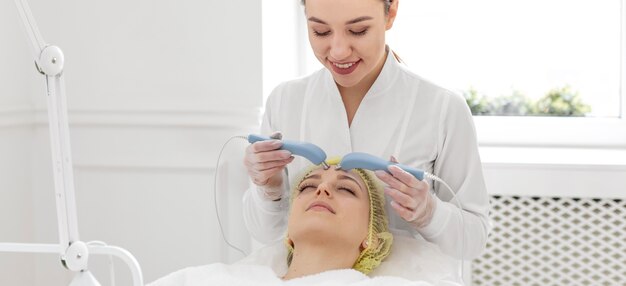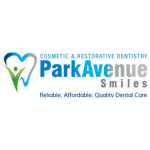
Unveiling Tummy Tuck Scars: What to Expect and Where
A tummy tuck, or abdominoplasty, is a transformative surgery that creates stunning and incredible dimensions for many patients. However, there are many concerns regarding the scarring from an abdominoplasty. This is understandable, as any potential surgery can feel frightening, especially regarding scarring. Patients need to be aware of scarring location and prominence. This can help ease concerns and allow you to make an informed decision.
Along the Lower Abdomen: The Main Incision
Excess skin is removed from the middle and lower abdomen during a full tummy tuck and includes an incision across the lower waist from hip to hip. This incision creates the space visibility for your cosmetic surgeon to eliminate skin and fat from the lower abdomen and the region slightly above the belly button.
A tummy tuck creates a flatter, toned abdominal region and can remove stretch marks in the skin. However, the scar from an abdominoplasty is inevitable as this incision is necessary to create a flatter, toned stomach. The length and visibility of the scar depend on the type of tummy tuck performed and the amount of excess skin removed during the procedure. However, most tummy tuck scars are discreetly placed low on the pelvic region and can be hidden underneath clothes and swimsuits.
Around the Belly Button: Secondary Incision
A full tummy tuck Bellevue can include the incision from hip bone to hip bone as well as a minor incision above the navel. This secondary incision allows the surgeon to restructure the belly button, remove overhanging skin, and eliminate stretch marks that reach higher up on the abdominal region. It also allows the leftover skin to be reshaped and placed in a better location.
The belly button incision is necessary to reshape and reposition the navel and create an aesthetically pleasing core. The scar around the navel is minimal and typically fades over time but does not entirely disappear. Sometimes, the reshaped belly button can change structure with time but never return to its original appearance.
Less Scarring with Mini-Tummy Tuck: A Variation
A mini tummy tuck is a less invasive procedure that creates a smaller scar for those needing minimal skin removal. A mini tummy tuck Bellevue is another type of abdominoplasty that creates a flatter and tighter lower waist. It only removes the appearance of a pooch or overhanging skin in the low abdomen.
The scar from a mini tummy tuck is smaller and runs along the low pubic line, reaching the hips. It does not include a secondary scar above the belly button and requires less downtime during recovery. However, it does not remove as much skin as a full tummy tuck and only focuses on the lower portion of the stomach. Most patients prefer a full tummy tuck for extensive results.
Individual Variations and Considerations
Every patient is unique and responds differently to a cosmetic procedure. The visibility and prominence of a tummy tuck scar depends on the individual patient, their genetics, and how well they care for their scar. Keeping up with topical scar treatments, eating a healthy diet, drinking plenty of water, and avoiding direct contact with the sun can help minimize the appearance of your scar.
Being open and honest with your board-certified cosmetic surgeon about your concerns and potential scarring is essential. During a consultation, your provider can help you make an informed decision and guide you to the right surgery for your needs and overall goals.
Choosing the Right Procedure: Factors to Consider
Potential scarring is not the only factor to consider when deciding if a tummy tuck Bellevue is right for you. When deciding which type of tummy tuck is best for you, consider the amount of skin you need removed. While a mini tummy tuck may have more minimal scarring, it also removes a minimal amount of skin from the lower abdomen.
Both surgeries have incredible benefits depending on your aesthetic goals and concerns. A full tummy tuck provides dramatic results that can reshape the lower abdomen and belly button. However, a mini tummy tuck can help create a beautiful, flat shape for the lower abdomen and has less scarring and downtime.
Conclusion
A full tummy tuck leaves a thin scar from hip to hip and one above the navel. A mini tummy tuck only has one smaller incision that does not reach the hips. However, the scars from a tummy tuck can be well hidden and are not as prominent as you may believe. Open communication with your board-certified plastic surgeon is the best way to determine which procedure is best for you. With time, adequate care, and an experienced provider, scarring from a tummy tuck is nothing to worry about. A tummy tuck Bellevue is a transformative surgery that can increase your shape and confidence.

Unlocking Your True Self: The Objective Path to Facial Feminization Surgery
What is Facial Feminization Surgery (FFS)?
Facial feminization surgery—often abbreviated as FFS—is a gender affirming procedure commonly performed on transgender women. The surgery consists of a combination of facial procedures designed to take traditionally male-presenting features and make them look more female-presenting. This could include surgeries like a brow lift, chin reduction, lip lift, rhinoplasty, and several others.
No two facial feminization surgeries will look exactly alike. The best facial feminization surgery is customized to fit the patient and does not unnecessarily operate on areas that the patient is happy with or which already align well with their preferred gender.
In comparison to the lengthy history of other medical procedures and technologies, facial feminization surgery only began in the twentieth century. The earliest cases of gender affirming surgery took place largely in Germany at the Hirschfeld Institute or otherwise supervised by Dr. Hirschfeld—one of the first doctors to study gender and gender dysphoria.
World War II proved to be a setback in gender affirming care when much of Hirschfeld’s research and his facility were destroyed. Thankfully, hormone therapy became available and greatly benefited transgender people of the time. Gender affirming body surgeries began to take place in more places around the world including the United States.
In 1983, facial feminization surgery emerged in San Francisco. Dr. Douglas Ousterout—a craniofacial surgeon who specialized in plastic surgery—is considered the “father” of facial feminization surgery. Many of the techniques he developed are still used today. It started with a forehead feminization procedure and slowly other procedures like hairline lowering and tracheal shave were added.
Since the 1980s, surgeons all around the world have continued to learn and improve upon FFS techniques. It is now a fairly common surgery for transgender women to seek out.
Reasons to Consider FFS
Transgender people seek gender affirming surgery like facial feminization because it can help treat and alleviate gender dysphoria. Gender dysphoria is a medical term that recognizes the mental anguish, anxiety, depression, and even suicidal thoughts that can come from feeling like their physical form is incorrect or incongruent with their gender assigned at birth.
The severity and degree to which a person may experience gender dysphoria will vary. Some experience no dysphoria, others may only feel it surrounding certain parts of the body, and, finally, some may experience a much more widespread gender incongruence.
Facial feminization takes traditionally masculine features and makes them appear more feminine. A few ways it may do this include narrowing the jaw, reducing the size of the chin, lowering the hairline, shortening and narrowing the nose, reducing the size of the forehead, creating a rounder-looking forehead, and addressing a noticeable Adam’s apple. Of course, there are other possible procedures or results that surgeons may perform to help a patient better align with their individual identity.
Benefits of Facial Feminization Surgery
Transgender women who undergo facial feminization surgeries often experience many possible benefits such as:
- Softer, rounder facial features
- Smaller facial features and structure
- More of a rounded hairline
- Reduces gender dysphoria
- Allows the patient to more easily present as female publicly
- Can help improve symptoms of mental health issues such as anxiety, depression, etc.
- Improved confidence
- Helps boost self-esteem
- Patient is able to see a more accurate self-image in the mirror
- Permanent results
- Customized to fit the specific needs of the patient and their unique anatomy
What Does Facial Feminization Surgery Change?
The exact changes that a specific FFS procedure makes will differ between patients. Though, FFS can address almost every facial structure and feature:
- Hairline: Male hairlines often sit higher up on the skull, begin receding early, and take on more of an M shape. FFS can lower the hairline via hairline lowering surgery, and it can reshape the hairline through hair transplants.
- Forehead: A male forehead protrudes more prominently than a female one. They also tend to have a straighter profile and are larger. FFS helps reduce the projection of the forehead and may subtly reshape it so it takes on a more curved profile.
- Brows: Like the forehead, the male brow bone is much larger and protrudes noticeably. A surgeon may set the brow bone further back and also may shave down the orbital rims which contribute to the appearance of the brows.
- Nose: Female noses tend to be smaller, narrower, and often straighter. FFS commonly helps slim the nose and adjusts the size to better suit a female appearance.
- Midface: Female cheeks may be rounder and include higher cheekbones. While it is rare to get cheek implants, it is not unheard of. Many patients opt for non-surgical enhancements such as hyaluronic acid filler to address the cheeks.
- Lips: The distance between the bottom of the nose and the top lip is shorter in women. A lip lift can help shorten this distance as well as subtly create a more feminine lip appearance. For increased plumpness, many patients choose to get lip filler. However, lip implants are also an option.
- Chin: The female chin tends to be smaller and more rounded. This can be achieved through chin reduction surgery. In rare cases, a patient may benefit from a chin implant in addition to or instead of chin reduction surgery.
- Jaw: The jawline is often shaved to create a slimmer and rounder chin contour.
- Neck: Women do not have as prominent of an Adam’s apple so a tracheal shave can help reduce its projection.
Not every patient will have all of the features addressed. The best facial feminization surgery is custom tailored to meet a patient’s specific goals and needs.
Duration of FFS Results
For the most part, the results of FFS are considered permanent. For example, rhinoplasty, tracheal shave, and any shaving procedure are reliably permanent. Brow lifts and similar procedures may occasionally need touch-ups as a person ages. Additionally, any non-surgical procedures a patient may have done as part of FFS will need regular treatments to maintain results.
Complications of FFS
All surgeries have the potential for complications. As a usually long surgery that addresses multiple areas, FFS can have elevated risks for some patients. Possible complications include infection, visible or raised scarring, asymmetry, unsatisfactory results, and prolonged side effects.
Surgeons who perform the best facial feminization surgeon take steps to minimize and prevent complications:
- Thorough patient screening at the consultation and before surgery
- Patient may stay overnight for monitoring
- Hair transplant performed under local anesthesia to prevent too much time under general anesthesia
- Detailed post-operative instructions
- Regular follow-up appointments
- Starting or ceasing certain prescription medications before or after surgery
- Provide the patient with a realistic idea of recovery and results
Pain and Recovery After FFS
After surgery, it is normal to experience post-operative pain. The face does tend to swell and this can cause discomfort. Surgeons usually prescribe a pain medication and antibiotics. Patients may also take certain supplements to minimize and prevent bruising. However, patients should know that FFS can involve an intense recovery.
Patients will see side effects and pain subside significantly over the first two weeks. Residual swelling can last for months. Patients can usually return to work in two to three weeks. It can take two to three months for patients to get back to their full range of activities.
Recovery Timeline for FFS Surgery
In the initial days following FFS surgery, patients can expect to rest and focus purely on recovering. Patients often need to follow a liquid diet for at least a few days. After a week or so, most bandages can be removed and patients can become more active at home. Patients tend to discontinue prescription medication within a week.
After two to three weeks, patients can return to work and basic activities. However, they should continue to avoid exercise or anything strenuous. Swelling should have gone down significantly and patients should be much more comfortable than they were immediately after surgery.
Two to three months after surgery, patients can return to all of their activities. Some residual swelling may still be present, but largely unnoticeable. Patients can use makeup to hide scarring and should continue to protect their scars with clothing or strong sun protection.
Conclusion
The best facial feminization surgery allows patients more freedom and agency within their lives. It helps to alleviate gender dysphoria and can have other mental health benefits. However, there are drawbacks and risks that patients should be aware of before undergoing the surgery. Meet with a few surgeons, research, and go into FFS making an informed decision. This lets patients feel more confident and often happier with their procedure.

Demystifying Tummy Tucks Popular Questions Answered
What Does a Tummy Tuck (Abdominoplasty) Involve?
An abdominoplasty surgery—also known as a tummy tuck—involves making an incision from hip to hip on the lower abdomen. Commonly, the incision is placed just below the panty line. Occasionally, the incision may extend over the hips. Through this incision, the plastic surgeon removes excess skin and fat from the abdomen. Usually, they will also perform diastasis recti repair which stitches together separated abdominal muscles. This final step helps tone and further flatten the abdomen as well as promote long lasting results by strengthening the abdominal muscles.
Am I a Good Candidate For This Procedure?
Tummy tuck Sarasota patients do share traits that make them an all-around good candidate. A tummy tuck takes several hours to complete and can involve an intense recovery. Thus, requiring a prepared and well-informed patient. Some factors that determine candidacy include:
- Current medications
- Medical conditions
- Previous abdominal surgeries
- If a patient plans to have any future pregnancies
- Ability to withstand general anesthesia
- Amount of protruding stomach consisting of extra skin
- Age
- Long term outlook
- Patient’s understanding of the procedure
- Patient’s goals and expected results
A Few Example Patient Profiles:
After having three children, a woman in her 30s to 40s presents with stretched and separated abdominal muscles (diastasis recti). This has affected her ability to exercise and maintain urinary continence. The patient also has significant extra skin on her lower abdomen. The patient does not plan to have any more children. Thus, she is a good candidate for a traditional tummy tuck surgery.
A 35-year-old man lost over one hundred pounds and experienced sagging, loose skin as a result. The patient is within ten pounds of their final goal weight and has maintained their current lifestyle for several months. The patient could benefit from an abdominoplasty to remove the excess skin on his abdomen.
There are—of course—several other types of patients who may qualify for a tummy tuck. Pregnancy and major weight loss are the two most common causes of the need for abdominoplasty surgery. The best way to determine candidacy is to consult with a qualified plastic surgeon.
Will I Have Visible Scars?
Tummy tuck scars are designed to be placed below the panty line. Thus, they should be concealed by most undergarments and swimsuits. Certain kinds of tummy tucks—namely a fleur-de-lis tummy tuck—may involve more visible scars. Usually, tummy tuck scars are easy to conceal.
Your surgeon may provide tips for managing your scar during and after recovery. For example, making sure to keep the scar out of the sunlight for several weeks or months helps prevent the scar from becoming overly pigmented. Some surgeons may recommend silicone sheets or scar creams.
Can I Have a Mini Tummy Tuck (Mini Abdominoplasty) Instead of Full Abdominoplasty?
A patient may be a candidate for a mini tummy tuck if the extra skin does not extend above the belly button. The incision remains the same, but the abdominal muscles generally do not need to be repaired or tightened. The belly button also is not recreated or repositioned.
Mini tummy tuck patients will have less extra skin and may have tight and intact abdominal muscles. Some women may only need a mini tummy tuck after a single pregnancy or moderate weight loss. The majority of abdominoplasty patients qualify for a fully tummy tuck.
Will Liposuction Work Instead of a Tummy Tuck (Abdominoplasty)?
Liposuction is a minimally invasive surgery that uses a cannula to break up and remove excess fat. It involves only tiny incisions and can treat multiple areas. Many patients undergo liposuction and tummy tuck Sarasota together. In the right patient, they can complement the results of one another.
In rare cases, liposuction may replace a tummy tuck. This is only when no muscle repair is necessary, extra skin is minimal, and the skin is expected to adequately retract.
How Long Does It Take To See Results?
Like most cosmetic surgeries, results are considered final in nine to twelve months. However, patients may see significant results within three to six months. Factors that can slow down recovery include smoking, not following post-op protocols, and returning to activity too quickly.
How Long Do Results Last?
As long as a patient maintains a healthy and active lifestyle, they can expect to maintain their results long term. It is also important that a patient does not get pregnant after a tummy tuck if they want permanent results. Pregnancy stretches the abdominal muscles and often causes extra skin.
What is the Recovery Process Like?
Patients may experience some pain and discomfort after surgery. It tends to be the worst for the week following surgery. Major side effects like swelling and bruising should significantly improve within two to three weeks. Every surgeon will have their unique recovery protocols. However, patients can expect directions such as:
- Remain hunched over to prevent stress on the incision
- Sleep sitting at roughly a 45-degree angle
- Avoid strenuous activities for at least two to three weeks
- Do not smoke
- Get up and walk frequently
- Do not submerge the incision
- Keep the incision out of the sun
- Get adequate rest, eat a healthy diet, and stay hydrated
Will Tummy Tuck Surgery Help Me Lose Weight?
Tummy tuck surgery is not a weight loss surgery. It helps contour the body—especially after weight loss—by removing extra skin. On its own, it does not promote long term weight loss or management. While it can be motivating for some patients, it is not a reliable way to lose weight. Additionally, patients should be close to their goal weight before abdominoplasty surgery. Most patients do not lose any way as a result of tummy tuck surgery. It is best that patients have maintained their lifestyle for at least three months before undergoing a tummy tuck.
Does a Tummy Tuck (Abdominoplasty) Remove Fat?
A tummy tuck may reduce a small amount of abdominal fat. For the best results though, adding liposuction to a tummy tuck will remove more fat. If the primary concern is fat, patients may consider liposuction instead.
How Long Will I Need to Take Off Work After Surgery?
Patients should plan for about two to three weeks off work. However, patients with physical jobs may need longer off or to return on light duty. Every patient’s timeline will look slightly different. Factors that influence return-to-work timelines following a tummy tuck Sarasota include:
- How well the patient heals
- If the patient smokes
- Diabetes or similar conditions
- How well a patient adheres to post-surgery restrictions
- The type of job the patient works
- Pain level and how the patient manages it
When Will I Be Able to Return To My Normal Activities?
Patients may begin to return to light activities that do not place major stress on their incision after two to three weeks. This can include activities like walking, light aerobics, housework, and stretching. However, activities such as intensive cardio or weight lifting will likely need to wait six to eight weeks before resuming.
How Soon Can I Exercise After a Tummy Tuck (Abdominoplasty)?
Patients can take longer, light walks once they feel comfortable. Generally, surgeons recommend that patients wait until the two-week mark or when they no longer need to hunch over. The patient’s surgeon will advise them when they can return to all forms of activity. Thus, it is important to stay in contact with your surgeon post-surgery.
How Painful Is a Tummy Tuck (Abdominoplasty)?
Cosmetic surgeons generally prescribe pain medications following tummy tuck Sarasota surgery. Patients are encouraged to cease them as soon as they feel able. In addition to the pain medications, patients may also receive prescriptions for anti-nausea medication and antibiotics. Patients should take the medications as prescribed.
How Much Does Tummy Tuck (Abdominoplasty) Surgery Cost?
The cost of tummy tuck Sarasota depends on several factors such as location, experience of the surgeon, type of tummy tuck, and any special considerations necessary. Financing is available through outside sources such as Care Credit. Patients should be prepared and explore financial options before their consultation, if possible.
Is Tummy Tuck (Abdominoplasty) Surgery Covered By Insurance?
An abdominoplasty is rarely covered by surgery. One exception is in the case of a panniculectomy. While technically different from a tummy tuck, it performs much of the same purposes, and a tummy tuck is generally combined with pannus removal. A panniculectomy removes a stomach that hangs below the stomach and may obstruct other anatomy or make daily activity difficult.
Can I Combine Other Procedures With a Tummy Tuck?
Combining surgeries—when performed on a patient who is a good candidate for combined surgeries—can lessen recovery time when compared to undergoing two separate surgeries. It also allows patients to recover from both procedures at the same time, cutting overall recovery time. Common and popular combinations include tummy tuck with liposuction, tummy tuck with Brazilian butt lift, and tummy tuck with breast augmentation.
How Should I Prepare Before Surgery?
- To prepare for tummy tuck Sarasota surgery, patients should:
- Obtain any necessary medical clearances
- Secure financing if necessary
- Get time off work
- Make hotel, travel, and childcare arrangements
- Fill prescriptions before surgery
- Have different types of food on hand for recovery
- Wear button down or zip up clothing
What Happens If I Decide to Have More Children After Surgery?
There is no medical risk to having children after a tummy tuck surgery. However, it will likely reverse results and require a revision surgery if the patient hopes to maintain their original result. Patients should closely consider if they want more children or if they are okay with needing future surgery.
Are There Any Risks of Tummy Tuck (Abdominoplasty) Surgery?
Risks of a tummy tuck:
- Infection
- Raised or visible scarring
- Pain
- Muscle tightness
- Opening of the incision
- Skin death
Cosmetic surgeons reduce risk through several methods such as patient screening, limiting bleeding during surgery, and making patients follow pre-op instructions like quitting smoking. Patients may also need to alter their normal medications.
Preparing for Consultation
Dr. Alberico Sessa of Sarasota Surgical Arts has nearly two decades of experience providing the best tummy tuck Sarasota has to offer. When consulting with Dr. Sessa or any other surgeon, research them and the procedure first. Understand the type of results they provide and their credentials. Patients may also prepare questions to ask during the consultation:
- What types of tummy tuck do you perform?
- How do you minimize risk during surgery?
- What previous experience do you have with abdominoplasty surgery?
- Do you routinely combine tummy tucks with other surgeries?
- Do you offer financing options?
- How much does tummy tuck cost?
Patients will likely have their own questions which is encouraged. Make sure that you have all of the information you want and need before moving forward with the procedure. To learn more and schedule a consultation with Dr. Sessa, call us at 941-923-1736. Patients can also reach out online via chat, Price Simulator, and our contact form.

Empowering Physician Assistants with Botox Training: A Path to Enhanced Patient Care
Introduction to Botox Training for Physician Assistants
Physician assistants are extremely skilled medical providers. However, they also can get easily burnt out due to overwork and seeing rough outcomes frequently. Adding to their skill set can help PAs escape the exhausting and unpredictable hospital environment. Botox training can help PAs advance their career and have the opportunity to be their own boss, or at least work in a less stressful environment.
Aesthetic treatments—especially non-surgical ones—are rising in popularity. Social media, Zoom, and increased awareness of the signs of aging, more and more people are seeking out regular maintenance treatments such as Botox injections.
The Role of Physician Assistants in Aesthetic Medicine
Physician Assistants often end up performing the duties physicians do not want to do such as charting, consulting with patients virtually, and managing patient questions and prescriptions. It is easy as a PA to feel left out or like an afterthought. However, being part of an injectables practice or running your own can expand the scope of physician assistants and lead to a more fulfilling experience.
After Botox training for physician assistants, PAs become more valued members of the healthcare team, especially when working in an aesthetic clinic. Their experience and expertise become invaluable for the rest of the team and foster a much more welcoming and giving environment for providers and patients.
The Benefits of Botox Training for Physician Assistants
There are several benefits of Botox training for physician assistants:
- More positive patient outcomes
- See patients at their best instead of their worst
- Administer both cosmetic and medically based treatments in a low-stakes environment
- Diversify medical skills
- Help meet the demand for aesthetic injections
- Better work-life balance
- Offers more opportunities for career advancement
- Work in a smaller and less chaotic environment
- Build lasting relationships with patients
Accredited Botox Training Programs for PAs
Botox training for physician assistants should involve a credible course with hands-on training. While not all states require hands-on training, it is a vital component of becoming a competent and skilled aesthetic injector. Many courses only offer online courses consisting of videos, lectures, and potentially reading material.
The American Academy of Cosmetic Medicine offers a comprehensive Botox training program for physician assistants. Not only do they receive in-person instruction, but physician assistants will also get to inject on a live model (or a silicone model in certain cases). AACM offers both beginner and advanced courses for those with differing experience levels, comfort, and knowledge of Botox injections.
What to Expect in Botox Training for Physician Assistants
Depending on the chosen course, physician assistants can expect to learn skills that they will use frequently as an aesthetic injector. This may include routine Botox treatments such as frown lines or forehead lines. However, the advanced course also covers other uses of Botox such as for jaw slimming, lip enhancement, and chronic migraine treatment.
Hands-on experience ensures that physician assistants leave their Botox training confident in their knowledge and skills. At the end of the course, there is also an examination that can lead to Botox certification from AACM.
How Botox Training Enhances Patient Care
Regardless of whether a PA chooses to fully transition to aesthetic medicine, Botox training can enhance their medical skills. There are several medical uses for Botox and they can better serve patients by recommending or performing Botox treatment. Even in the aesthetic medicine field, certain medical concerns can be addressed such as migraines, hyperhidrosis, and an overgrown masseter muscle. These skills benefit physician assistants in a primary care setting as well as an aesthetic medicine setting.
Additionally, adequate Botox training for physician assistants gives patients more confidence in their providers. A certification from AACM helps patients know that they are in the right hands when it comes to their aesthetic injections.
Navigating Legal and Regulatory Aspects
Each state has its own laws and regulations concerning who can and cannot inject Botox. Physician assistants can inject in most states. Others may require that they work under a medical director who is a physician. PAs should check their state’s requirements to understand what licensure and certifications they may need.
Generally, as long as the person is qualified as a PA and has undergone a certain number of training hours, physician assistants can inject Botox. Many PAs can practice mostly independently when it comes to aesthetic injections.
The Future of Aesthetic Medicine and PAs
Cosmetic injectables have come a long way in just a few decades. They are likely to see a similar trajectory of advancement in the coming years. With more people seeking out non-surgical cosmetic procedures such as injections, it is smart to learn and understand the industry early on. Additionally, PAs serve a vital role in the aesthetic healthcare field. They bridge the gap between nurses and physicians—acting as a mid-level provider who can keep things running smoothly. PAs may also be able to perform more advanced procedures that nurses cannot.
How to Get Started with Botox Training as a Physician Assistant
The journey to becoming a certified Botox injector starts at the American Academy of Cosmetic Medicine. Our certification and training courses provide instructional and hands-on training vital for anyone wanting to enter the aesthetic medicine field. To enroll in our Botox training for physician assistants, fill out our contact form.
Transforming Your Career with Botox Training as a Physician Assistant
Entering the aesthetic medicine field provides physician assistants with the opportunity to grow professionally. The less stressful environment and seeing patients when they are healthy also leads to better patient interactions, outcomes, and care. Ultimately, a career in aesthetic medicine can be an extremely rewarding and fulfilling career. For physician assistants interested in making a shift to aesthetic medicine or who simply want to expand their skills, sign up for our Botox training for physician assistants.









